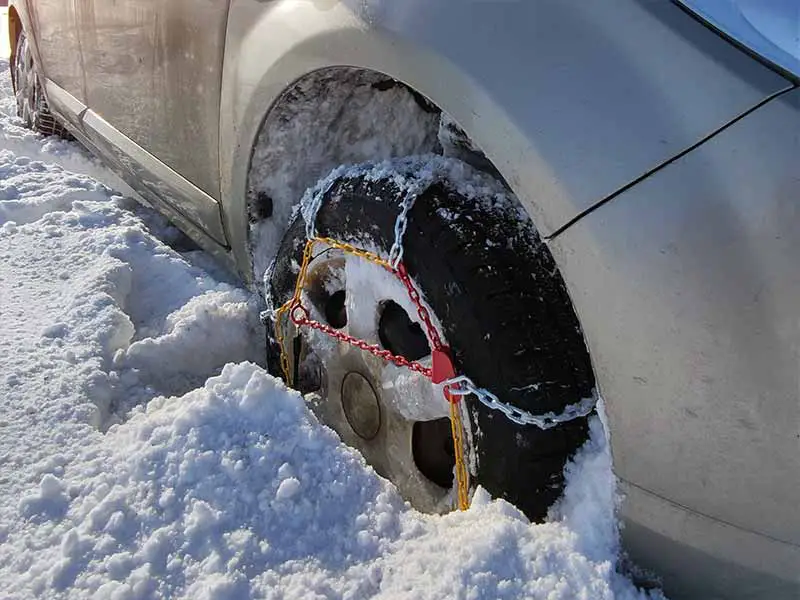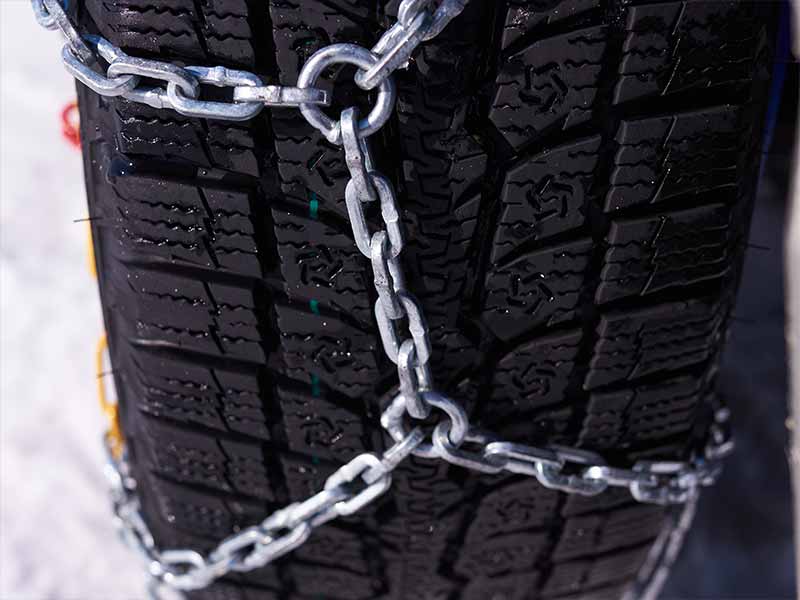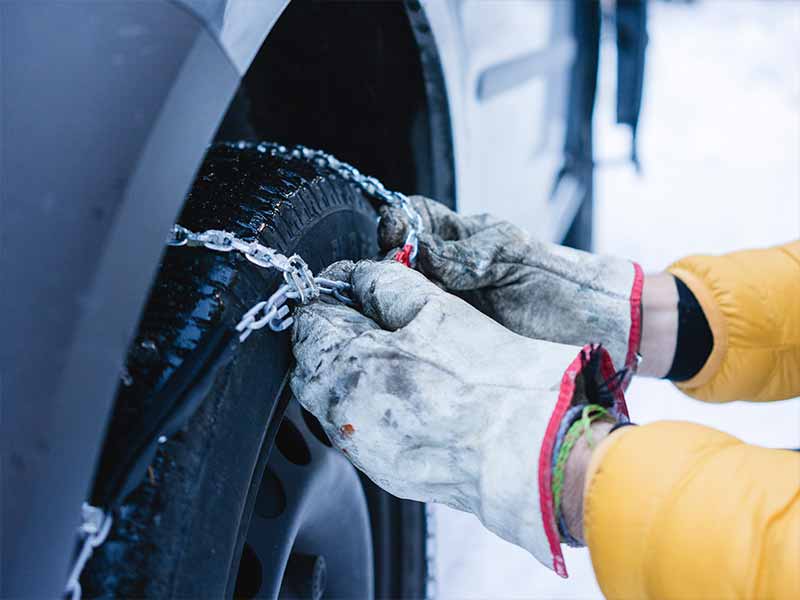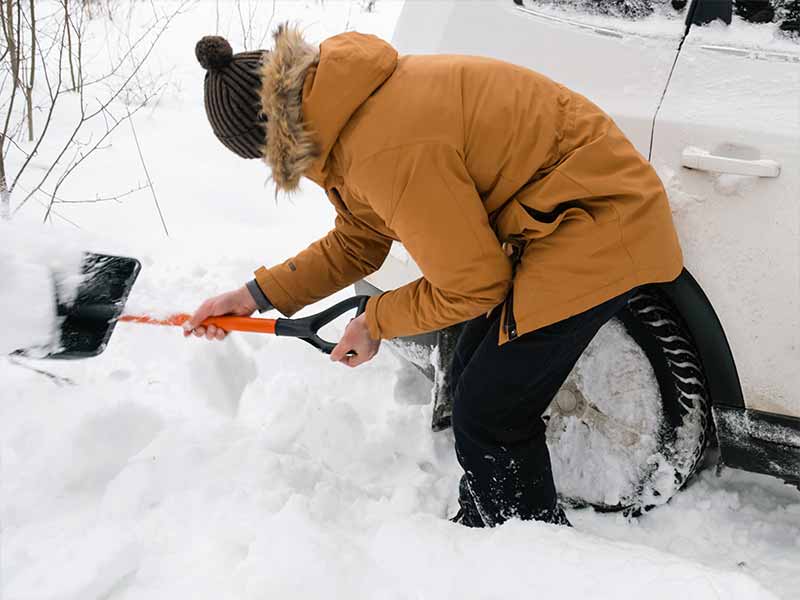Are you gearing up for winter driving and wondering about the right tire chains for your vehicle? Choosing the correct tire chains can be as tricky as navigating icy roads. Let’s demystify the process and ensure you’re equipped with the knowledge to make an informed decision!
What Size Tire Chains Do I Need?
Your set of tire chains should match your tire size found on your tire’s sidewall. This will ensure the snow chains fit properly for a secure fit that enhances traction on snowy or icy roads, ensuring safer winter driving.
In this article, we’ll explore everything you need to know about finding the right tire chains for your vehicle. From deciphering tire sizes to consulting your owner’s manual and understanding the importance of proper fitment, we’ll guide you through the process step by step.
Understanding Tire Size
Understanding your tire’s dimensions sets the stage for selecting the appropriate tire chains and ensuring a safe and secure fitment. Before diving into purchasing tire chains, it’s wise to grab your vehicle’s owner’s manual. It’s often a goldmine of information, offering specific recommendations regarding tire chains that suit your vehicle’s tires and size.
Decoding Tire Size
When you gaze at your tire’s sidewall, it’s like deciphering a code. The numbers and letters etched there tell a story about your tire’s dimensions. Let me break it down for you:
- Tire Width: The first number in the sequence typically represents the tire width, measured in millimeters from sidewall to sidewall. For example, if you see “225” on the tire, it means the tire’s width is 225 millimeters.
- Aspect Ratio: The aspect ratio comes next and is indicated by a forward slash (“/”) after the tire width number. This ratio is the tire’s height compared to its width. If you spot “60” after the slash, it means the tire’s height is 60% of its width.
- Wheel Diameter: Following the aspect ratio, there’s a number indicating the wheel diameter, measured in inches. This number signifies the size of the wheel the tire fits. For instance, if it reads “16”, it means the wheel is 16 inches in diameter.
How Tire Size Affects Chain Fitting
Understanding these tire size elements becomes crucial when considering tire chains. Here’s why:
- Matching Chains to Size: Tire chains come in various sizes to fit different tires. It’s essential to choose chains that match your tire’s size to ensure a proper fit. An incorrectly sized chain can be ineffective and even cause damage to your vehicle or tires.
- Impact on Traction: The right-sized tire chain not only fits properly but also maximizes traction. When the chain is the right size, it snugly fits your tire’s dimensions, providing the necessary grip for safer driving on snow-covered roads.
Check out our step-by-step guide on how to install snow chains for a comprehensive understanding of the installation process.

Auto Tightening Tire Chains
Determining the Right Chain Size
I cannot stress enough the importance of referring to your owner’s manual for guidance tailored to your specific vehicle. This step sets the stage for choosing the right tire chains, ensuring they not only fit your tires but also align with your vehicle’s requirements for optimal performance and safety.
Consulting the Owner’s Manual
Your vehicle’s owner’s manual isn’t just a booklet gathering dust in your glove compartment—it’s a treasure trove of information. This comprehensive guide often includes specific recommendations for tire chains compatible with your vehicle. Here’s why it’s your go-to source:
- Manufacturer’s Recommendations: The manual usually provides insights into the types and sizes of tire chains best suited for your vehicle. Manufacturers understand their vehicles best, making these recommendations valuable and reliable.
- Safety and Performance: Following the manufacturer’s guidelines ensures the selected tire chains won’t compromise your vehicle’s safety or performance. They’re tailored to complement your vehicle’s tire size and specifications.
Chain Size and Vehicle Type
Different vehicles have different needs, especially when it comes to tire chains. Let’s delve into the specifics:
- Passenger Cars: For standard passenger cars, certain chains are designed to offer enhanced traction without causing damage to the vehicle. These chains often have specific size recommendations suitable for passenger vehicle tires.
- Trucks and 4WD Vehicles: Trucks and four-wheel-drive vehicles may require more robust and specialized tire chains. These vehicles often have larger tires, necessitating chains that can handle the increased size and power without compromising safety or functionality.
In addition to size, the way tire chains are mounted can vary based on the vehicle type. Some chains may have specific mounting instructions to ensure a proper fit, making it imperative to select chains compatible with your vehicle’s specifications.
Be sure to check out our detailed comparison of the differences between studded tires and chains.

Selecting the Proper Fit
I can attest to the significance of choosing tire chains that fit your vehicle snugly. The correct fit ensures not only effective traction but also safeguards against potential damage to your tires or vehicle.
Considering Chain Design
Understanding the design elements of tire chains is crucial. Let’s explore:
- Cross Chains: These are the diagonal chains that form the pattern across the tire tread. The design of these cross chains can vary, impacting the chain’s effectiveness in providing traction on snowy or icy roads.
- Side Chains: Side chains connect the cross chains and secure the tire chains onto the tire. They play a crucial role in ensuring the chains remain properly fitted and aligned.
Different chain designs cater to various conditions and tire types. Some designs may offer better traction or durability, while others prioritize ease of installation.
Ensuring Correct Fitment
Achieving the right fit for tire chains involves a couple of key considerations:
- Chain Height: Ensuring the height of the tire chains matches the height of your tires is crucial. Chains that are too tall or too short may not provide the necessary traction and can potentially damage your vehicle.
- Secure Attachment: Properly fitting chains should securely attach to the tire without excessive slack. A snug fit ensures the chains stay in place and function effectively while driving on snow-covered roads.
Installing tire chains according to manufacturer guidelines and ensuring they fit snugly is vital for your safety and the well-being of your vehicle.
Curious about the differences between snow chains and cables? Learn more about these alternative traction devices.

Different Types of Snow Chains
Snow chains come in various designs, each tailored to different driving needs and vehicle specifications. Understanding the different types can help you select the most suitable chains for your winter driving adventures.
Traditional Link Chains
- Description: These chains consist of interlocking metal links, offering robust traction on snowy or icy roads.
- Benefits: Known for their durability and excellent grip in severe winter conditions.
- Considerations: They might produce more noise and vibration compared to other chain types, and installation could be more labor-intensive.
Cable Chains
- Description: Made of steel aircraft cables twisted around the tire, these chains are lighter and easier to install than traditional link chains.
- Benefits: Less cumbersome and suitable for less extreme winter conditions while still offering decent traction.
- Considerations: May not provide as much traction as traditional link chains in severe snow or ice.
Composite Chains
- Description: Constructed using a combination of metal and high-performance polymers, these chains aim to reduce weight and offer moderate traction.
- Benefits: Lighter than traditional chains and less likely to cause damage to road surfaces or vehicle components.
- Considerations: While providing reasonable traction, they might not perform as well as traditional link chains in very icy or deep snow conditions.
What Does Class S Mean On Tire Chains?
Class S indicates a specific type of snow chain designed for vehicles with limited wheel well clearance. Here’s what it means:
- Definition: Class S chains meet the minimum requirements for clearance between the tire and vehicle body parts, typically found in passenger cars and some light trucks.
- Characteristics: These chains have a narrower cross-section compared to other chains, ensuring compatibility with vehicles that have restricted space between the tire sidewall and vehicle components.
When purchasing snow chains, ensure they meet the Class S requirements if your vehicle specifications indicate limited clearance. Always refer to your vehicle’s manual for specific recommendations regarding tire chains, including whether Class S chains are suitable for your vehicle.

Installing Snow Chains: A Step-by-Step Overview
Installing snow chains on your car or truck is a critical step to prepare for driving in wintry conditions. The process might seem daunting at first, but with a bit of practice and the right technique, it becomes more manageable.
Here’s an overview of how to install snow chains effectively:
Placement of Snow Chains
- Front or Rear Tires: For front-wheel-drive vehicles, it’s generally recommended to install snow chains on the front tires. This placement helps with traction during acceleration and steering in snowy conditions. Conversely, for rear-wheel-drive vehicles, it’s advisable to install chains on the rear tires.
- All 4 Tires or Just 2: While having snow chains on all four tires provides optimal traction and control, in some cases, having them on just two drive wheels can suffice. However, this setup might lead to differences in handling and stability between the front and rear of the vehicle, which can impact overall control.
Step-by-Step Installation
- Choose a Safe Spot: Find a flat, safe area to install the chains. Avoid icy or steep slopes when installing chains.
- Lay Out the Chains: Lay the chains flat on the ground and ensure they’re not tangled. Identify the correct orientation (inside/outside) and position them accordingly.
- Wrap Chains Around Tires: Drape the chains over the tire, ensuring they’re evenly distributed on both sides.
- Connect and Fasten: Fasten the chains snugly around the tire, ensuring they’re centered. Connect the hooks or fasteners securely.
- Drive a Short Distance: After installation, drive a short distance and check the chains’ tension. Re-adjust if needed to ensure a proper fit.
Remember, following the manufacturer’s instructions specific to the snow chains you’ve purchased is crucial for a successful installation. Additionally, practicing installation in ideal conditions beforehand can help familiarize you with the process and make it easier to handle when snow or ice cover the roads.
Always prioritize safety when installing snow chains and consider practicing installation before you encounter harsh winter conditions on the road.
Resources
Below are some links you may find helpful when learning about tires:
- How to buy the right tire chains – etrailer.com
- How to fit snow chains to car tyres – easy guide – Chamonix
Final Thoughts
Choosing the right tire chains boils down to understanding your tire size, consulting your vehicle’s manual for recommendations, and ensuring a proper fit. Tire chains significantly enhance traction on snowy roads, but their effectiveness hinges on selecting the correct size and design that aligns with your vehicle’s specifications. By following the guidelines outlined here, you can confidently prepare your vehicle for safe and secure winter driving.
Remember, accurate tire sizing, consulting your vehicle manual, and ensuring a snug fit are pivotal for the optimal performance of tire chains. Drive safely and enjoy the winter season!
Good luck and happy motoring.




